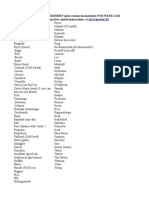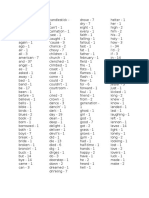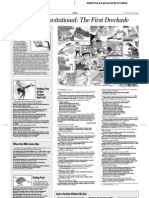Professional Documents
Culture Documents
Balmain On Scanlan
Uploaded by
Pat Myers0 ratings0% found this document useful (0 votes)
84 views6 pagesOriginal Title
Balmain on Scanlan
Copyright
© Attribution Non-Commercial (BY-NC)
Available Formats
PDF, TXT or read online from Scribd
Share this document
Did you find this document useful?
Is this content inappropriate?
Report this DocumentCopyright:
Attribution Non-Commercial (BY-NC)
Available Formats
Download as PDF, TXT or read online from Scribd
0 ratings0% found this document useful (0 votes)
84 views6 pagesBalmain On Scanlan
Uploaded by
Pat MyersCopyright:
Attribution Non-Commercial (BY-NC)
Available Formats
Download as PDF, TXT or read online from Scribd
You are on page 1of 6
REVIEWS & REFLECTIONS
Wey
Featured Poet: ¥
Mae Scanlan
F yout a fan of ZINES ctess: sacs as
Mec Seulaa Hellmadk Fodos
adn had tthe Nena
‘engin lenges we Pu Sate che
Tigi reader who and har husband,
isnt—ie won't
shock youro learn she’sa pianist
‘Who buc a seasoned musician
could give so many poems such
2 catchy, rollicking beat “Is
not that Im a great player,”
she says, after mentioning that
‘every month for 22 yeass, she
hhas played during happy hour
at 2 nursing home, “les that
1 just happen co know all the
cold songs of the ‘20s, '30s, and
40s, and chis brings smiles to
the faces of even these who canlt
oF move.
Youll also find it_makes
perfect sense that for 28
years, Scanlan has been
2 photographer. Like a
welkdeveloped picture, her
poems tend to have just the
right balance of subject and
background, telling detail, and
(of course) light. Uniil 2004,
she worked full rime as a stock
photographer—shooting what
she liked, then selling to
‘Tom, trad wide
vasa result, and also produced a
book about their hometown:
Beautiful America’s Washington,
D.C. (Scanlan, who has lived
in D.C. most of her life, took
the photos; Tom, a retired
joumalist, wrote the text.) As
in Scanlan's poetry, some of her
favorite sub-jects are animals
and—when their parents
aren't around —children,
“Parents always wane kids to
comb their hair and smile for
the camera,” she says, “but
sometimes theyre much cuter
with a stray piece of hair or a
sagging pant leg”
‘Whet may amaze you,
though—what defies logie—
is that Scanlan has found
any time to write. Not only
is she a photographer and
pianist, she's also 2 mother
of two grown children: a
grandmother of three; a
caretaker ther husband
(who has suffered a stoke and
other health problems)s and a
“surrogate grandparene’ © the
10 or so kids who live on ker
block. Nonetheless, Scanlan’s
output so fai—published and
aov—is probably enough co
paper every room in her bouse,
plus the rooms ofall 10 of those
Kids. “I have boxes and boxos,”
Scanlan says, containing pocms
thar date clear back to her
childhood.
A partial inventory of her
work: about 1,000 limerickss
hundreds of poems for children
(ome have been anthologized);
dozens of poems in Light scores
of contest-winning poems in
The Washington Post and such
British publications as Literary
Review, Lighten Up Online, and
The Spectator (ix which she was
the firse American ever to win
highest honors); at least 100
song parodies, some of which
have been performed by the
National Press Clubs and abou
a dozen mostly-political poems
that appeared in The Washington
Times from ‘98299. (The Times
sig ended when the paper
switched editorial directors. “It
was just a5 wel,” Scanlan says,
“sincel takea different view from
the paper on most things.”)
‘What's her secret to prod-
uctivity? Simple, she says: she
writes almost everywhere. On
planes, trains, and the Metro,
for instance, In doctors’ waiting
rooms. On park benches. In
restaurants. And, of course,
at home. The only place she
niiely writes is on a computer,
which she finds incompatible
with poezry’s starts and stops
and thinking spells. “I write
Ionghand on a drugstore pad,”
she says. “T sit in my chair with
my cup of ea... IfThave to sit
and think, T prefer be in an
easy chair. I'm big on rewrites.
Tdo a lot of crossing ous, sub-
sicuting words, sometimes
tossing out an entire vere. Ie
goes through a lor before | feel
like, ‘OK, this is the poem.”
Her effort shows in her
scemingly effordess results,
which range from epigrammatic
to neurly-epic, from peevish
to prising In the praise
deparement, Scanlan has mem
corably extolled such subjects
as oysters, dogs, sparulss,
bathrubs, London fog, cats, and
the humble mop:
A Quiet Thank You
“Hero he man wo invented
themop,
Fordhs spi tol che
cxamofihe op,
Then mary peson, inci
ovvilige,
Immunew th pespaxof
blag andspilags.
(Copa Theregoscfceall
‘ove the oo,
Ouceomsstemopand the
cafes no more.
Palvizal Chesiossippes
ofsnals,
PddescFrandopsand wee
rmudéy ads,
Dropped conssoficecram,
and tippal ensof paint
Mop the sou Bigmess..
then ai,
‘Mankind ria things
shar gil eck ord
Alar eraed by he sth of
hemp.
Tvloxdyo know thar when
shings go sms
“Thentabraysaaudy ld
sp santinghy
T wishsome aveneor would
malic hi gal
Toaywooncup wih amp
forthesoul.
Among topics Scanlan has,
conversely, singled out for scorn:
Abbott and Costello. Sonny
and Cher, lost luggage, croquet,
skimpy girls’ clothes, lead~
tainted toys, and politicians—
often in the form of song
parodies. Songs come naturally
to her, afterall. She has writeen
more than 20 original ones since
carly adulthood—Iyrics and
music—and published three.
One of these, a “tear-jerker”
about 2 shipwreck that she
peaned soon after college, was
nearly her ticket ro fame. “Ie was
country-western type song,”
she says, “aad was supposed to
be recorded by Eddy Amold,
‘who was then the No. 1 singer
in his category—and. always
soli a million or more records
of any song he recorded. I was
beside myself with glee. But, at
the last minute, it turned out he
hhad a contractual problem and
couldn't do it ail the next yeas,
and my publisher [RCA Victor]
didn’t want to wait, so gave it co
young unknown. Ic gor good
reviews, but never really made
igs Igoe small royalty checks
for a few years and that was
that.” Bad news for Scanlan,
pethaps—bue excellent news
for lighe-verse fans. If she had
gone on co write full sime for
You might also like
- Her Body and Other Parties: StoriesFrom EverandHer Body and Other Parties: StoriesRating: 4 out of 5 stars4/5 (821)
- The Sympathizer: A Novel (Pulitzer Prize for Fiction)From EverandThe Sympathizer: A Novel (Pulitzer Prize for Fiction)Rating: 4.5 out of 5 stars4.5/5 (119)
- Devil in the Grove: Thurgood Marshall, the Groveland Boys, and the Dawn of a New AmericaFrom EverandDevil in the Grove: Thurgood Marshall, the Groveland Boys, and the Dawn of a New AmericaRating: 4.5 out of 5 stars4.5/5 (265)
- The Yellow House: A Memoir (2019 National Book Award Winner)From EverandThe Yellow House: A Memoir (2019 National Book Award Winner)Rating: 4 out of 5 stars4/5 (98)
- A Heartbreaking Work Of Staggering Genius: A Memoir Based on a True StoryFrom EverandA Heartbreaking Work Of Staggering Genius: A Memoir Based on a True StoryRating: 3.5 out of 5 stars3.5/5 (231)
- The Little Book of Hygge: Danish Secrets to Happy LivingFrom EverandThe Little Book of Hygge: Danish Secrets to Happy LivingRating: 3.5 out of 5 stars3.5/5 (399)
- Hidden Figures: The American Dream and the Untold Story of the Black Women Mathematicians Who Helped Win the Space RaceFrom EverandHidden Figures: The American Dream and the Untold Story of the Black Women Mathematicians Who Helped Win the Space RaceRating: 4 out of 5 stars4/5 (890)
- Team of Rivals: The Political Genius of Abraham LincolnFrom EverandTeam of Rivals: The Political Genius of Abraham LincolnRating: 4.5 out of 5 stars4.5/5 (234)
- The Emperor of All Maladies: A Biography of CancerFrom EverandThe Emperor of All Maladies: A Biography of CancerRating: 4.5 out of 5 stars4.5/5 (271)
- Shoe Dog: A Memoir by the Creator of NikeFrom EverandShoe Dog: A Memoir by the Creator of NikeRating: 4.5 out of 5 stars4.5/5 (537)
- On Fire: The (Burning) Case for a Green New DealFrom EverandOn Fire: The (Burning) Case for a Green New DealRating: 4 out of 5 stars4/5 (73)
- The Unwinding: An Inner History of the New AmericaFrom EverandThe Unwinding: An Inner History of the New AmericaRating: 4 out of 5 stars4/5 (45)
- The Subtle Art of Not Giving a F*ck: A Counterintuitive Approach to Living a Good LifeFrom EverandThe Subtle Art of Not Giving a F*ck: A Counterintuitive Approach to Living a Good LifeRating: 4 out of 5 stars4/5 (5794)
- Grit: The Power of Passion and PerseveranceFrom EverandGrit: The Power of Passion and PerseveranceRating: 4 out of 5 stars4/5 (587)
- The World Is Flat 3.0: A Brief History of the Twenty-first CenturyFrom EverandThe World Is Flat 3.0: A Brief History of the Twenty-first CenturyRating: 3.5 out of 5 stars3.5/5 (2219)
- The Gifts of Imperfection: Let Go of Who You Think You're Supposed to Be and Embrace Who You AreFrom EverandThe Gifts of Imperfection: Let Go of Who You Think You're Supposed to Be and Embrace Who You AreRating: 4 out of 5 stars4/5 (1090)
- The Hard Thing About Hard Things: Building a Business When There Are No Easy AnswersFrom EverandThe Hard Thing About Hard Things: Building a Business When There Are No Easy AnswersRating: 4.5 out of 5 stars4.5/5 (344)
- Never Split the Difference: Negotiating As If Your Life Depended On ItFrom EverandNever Split the Difference: Negotiating As If Your Life Depended On ItRating: 4.5 out of 5 stars4.5/5 (838)
- Elon Musk: Tesla, SpaceX, and the Quest for a Fantastic FutureFrom EverandElon Musk: Tesla, SpaceX, and the Quest for a Fantastic FutureRating: 4.5 out of 5 stars4.5/5 (474)
- Style Invitational Congress List 2017Document1 pageStyle Invitational Congress List 2017Pat MyersNo ratings yet
- Week 1222 Horse NamesDocument1 pageWeek 1222 Horse NamesPat Myers100% (3)
- "A Symbol-Minded Solution" by Joel AchenbachDocument10 pages"A Symbol-Minded Solution" by Joel AchenbachPat MyersNo ratings yet
- Style Invitational Week 1274 Horse NamesDocument1 pageStyle Invitational Week 1274 Horse NamesPat MyersNo ratings yet
- The Life of A Pumpkin, by Brady Holt (Age 8), 1997Document1 pageThe Life of A Pumpkin, by Brady Holt (Age 8), 1997Pat MyersNo ratings yet
- Depravda, November 1995Document5 pagesDepravda, November 1995Pat MyersNo ratings yet
- Style Invitational Week 1052 Crossword Grid With CluesDocument1 pageStyle Invitational Week 1052 Crossword Grid With CluesPat MyersNo ratings yet
- Style Invitational Week 1061: Bob Klahn's Original CrosswordDocument1 pageStyle Invitational Week 1061: Bob Klahn's Original CrosswordPat MyersNo ratings yet
- Results of Style Invitational Week 524Document4 pagesResults of Style Invitational Week 524Pat MyersNo ratings yet
- For Style Invitational Contest Week 1172: List of Words Appearing in "American Pie"Document2 pagesFor Style Invitational Contest Week 1172: List of Words Appearing in "American Pie"Pat MyersNo ratings yet
- Depravda, November 1995 (Part 2)Document5 pagesDepravda, November 1995 (Part 2)Pat MyersNo ratings yet
- Chuck Smith, WoodbridgeDocument10 pagesChuck Smith, WoodbridgePat MyersNo ratings yet
- And The Weenies Are - . . Celebrating The Style Invitational's Fifth Anniversary by Gathering Its Best, Most Loyal Contestants, Treating Them Like Dirt, and Making Them Be Funny On The SpotDocument5 pagesAnd The Weenies Are - . . Celebrating The Style Invitational's Fifth Anniversary by Gathering Its Best, Most Loyal Contestants, Treating Them Like Dirt, and Making Them Be Funny On The SpotPat MyersNo ratings yet
- Original Crossword Clues For The Style Invitational's Week 1007 PuzzleDocument1 pageOriginal Crossword Clues For The Style Invitational's Week 1007 PuzzlePat MyersNo ratings yet
- Style Invitational 10th-Anniversary Retrospective, The Washington Post (Page 1 of 3)Document1 pageStyle Invitational 10th-Anniversary Retrospective, The Washington Post (Page 1 of 3)Pat MyersNo ratings yet
- Style Invitational 10th-Anniversary Retrospective, The Washington Post (Page 3)Document1 pageStyle Invitational 10th-Anniversary Retrospective, The Washington Post (Page 3)Pat MyersNo ratings yet
- Gladiator Feature Page Top 3-7-74Document1 pageGladiator Feature Page Top 3-7-74Pat MyersNo ratings yet
- Style Invitational 10th-Anniversary Retrospective, The Washington Post (Page 2 of 3)Document1 pageStyle Invitational 10th-Anniversary Retrospective, The Washington Post (Page 2 of 3)Pat MyersNo ratings yet
- Style Invitational Week 560 ResultsDocument3 pagesStyle Invitational Week 560 ResultsPat MyersNo ratings yet
- 606 Magazine Titles For Use in Week 996 of The Washington Post's Style Invitational ContestDocument5 pages606 Magazine Titles For Use in Week 996 of The Washington Post's Style Invitational ContestPat MyersNo ratings yet
- 606 Magazine Titles For Use in Week 996 of The Washington Post's Style Invitational ContestDocument5 pages606 Magazine Titles For Use in Week 996 of The Washington Post's Style Invitational ContestPat MyersNo ratings yet
- Gladiator Front Page 4-14-72Document1 pageGladiator Front Page 4-14-72Pat MyersNo ratings yet
- Gladiator Super Student 4-28-72Document1 pageGladiator Super Student 4-28-72Pat MyersNo ratings yet
- Style Invitational Week 644 ResultsDocument4 pagesStyle Invitational Week 644 ResultsPat MyersNo ratings yet
- Gladiator Super Student 4-28-72Document1 pageGladiator Super Student 4-28-72Pat MyersNo ratings yet
- Gladiator Sports 3-7-74Document1 pageGladiator Sports 3-7-74Pat MyersNo ratings yet
- Gladiator Super Student 4-14-72Document1 pageGladiator Super Student 4-14-72Pat MyersNo ratings yet
- Gladiator Super Student 4-14-72Document1 pageGladiator Super Student 4-14-72Pat MyersNo ratings yet
- Gladiator Front Page 4-14-72Document1 pageGladiator Front Page 4-14-72Pat MyersNo ratings yet
- Gladiator Sports 3-7-74Document1 pageGladiator Sports 3-7-74Pat MyersNo ratings yet

































































